Polish railway signalling
The Polish railway signalling system provides a complex outlook of traffic situations, yet is quite easy to understand. Signals can be divided into following categories:
- near and distant displays — signals (semi-automatic, automatic)
- distant-only displays
- repeater signals
- shunting signals
Most signals are colour lights.
On few stations remained mechanical signals, as well as old colour light signals.
Colour light signals
Semi-automatic signals
Semi-automatic is the most important type of signal on Polish railways. Its name reflects the fact that it switches to a red (stop) aspect automatically after a train has passed it but it must be switched back to clear by an explicit action from a signal box or dispatch centre. It is the typical signal in use at stations.
A semi-automatic signal can be recognized by its post which is painted with red and white strips. Dwarf versions have their boxes painted so.
A red (stop) aspect on a semi-automatic signal must not be passed.
As presented on this compact chart, semi-automatic signals can display both near and distant functions. Near signals either command a stop or impose a certain speed limit beginning at that signal. Distant signals tell the driver what to expect at the next signal, especially when braking is required.
| Distant signal | ||||
|---|---|---|---|---|
| Vmax | 100 km/h | 60 or 40 km/h | Stop | unspecified |
 | ||||
 |
 |
 |
 |
 |
| Vmax | 100 km/h | 60 km/h | 40 km/h | Stop |
| Near signal | ||||
| All permitted aspects on semi-automatic signals: | |
|---|---|
 | S1 stop |
| Proceed or speed reduction order: | |
    |
S2 clear, proceed at Vmax S3 reduce speed to 100 km/h S4 reduce speed to 60 or 40 km/h S5 stop at next signal |
| Speed limit 100 km/h: | |
    |
S6 speed limit 100; will be Vmax after next signal S7 speed limit 100; will be 100 after next signal S8 speed limit 100; will be 60 or 40 after next signal S9 speed limit 100; will be stop at next signal |
| Speed limit 60 km/h: | |
    |
S10a speed limit 60 km/h; will be Vmax after next signal S11a speed limit 60 km/h; will be 100 after next signal S12a speed limit 60 km/h; will be 60 or 40 after next signal S13a speed limit 60 km/h; will be stop at next signal |
| Speed limit 40 km/h: | |
    |
S10 speed limit 40 km/h; will be Vmax after next signal S11 speed limit 40 km/h; will be 100 after next signal S12 speed limit 40 km/h; will be 60 or 40 after next signal S13 speed limit 40 km/h; will be stop at next signal |
Other speeds
Since 2007 the Ie-1 code which regards signalling allows other speed limits. They are indicated by a number representing the speed in tens of km/h (e.g. 5 means 50 km/h) which is lit only with adequate aspect of the signal. These numbers are incorporated into signalling so, that they always loosen the restriction presented by the aspect of signal.
- speed 50 km/h is indicated by digit 5 with aspects S10—S13
- speeds 70, 80, 90 km/h are indicated by digits 7, 8, 9 with aspects S10a—S13a
- speed 130 km/h is indicated by number 13 with aspects S6—S9
On distant signals and repeaters these other speeds are not displayed, therefore more restrictive aspect is effectively announced.
Nameplates
Semi-automatic signals on a station are tagged with consecutive letters of Latin alphabet, or with a letter followed by a number.
The nameplates also contain speed indication which appears as a superscript or a fraction. The numbers have following meaning:
- 1 this signal is followed by a switch with straight direction, Vmax is possible
- 2 this signal is followed by a switch with diverging direction of 40 km/h
- 3 this signal is followed by a switch with diverging direction of 100 km/h
- 4 this signal is followed by a switch with diverging direction of 60 km/h
Therefore, a nameplate H 1/2 means a signal named H that aside S1 will also display S2-S5 aspects for straight direction and S10-S13 for diverging direction. Whereas P3 2 means a signal of name P3 that aside S1 only displays S10-S13 aspects because it is only followed by diverging direction.
There may also be a letter m which specifies that this signal also functions as a shunting signal (see below).
Subsidiary signal
| Subsidiary Signal | |||
|---|---|---|---|
 |
 |
 |
Sz, the subsidiary signal (Pol. sygnał zastępczy) is a signal issued in case of malfunction.
The first picture presents a typical case where the dispatcher cannot change the signal from S1. |
Automatic signals
Automatic signals are used on lines equipped with automatic block signaling. Their colour language is the same as aspects S1-S5 of semi-automatic signals. The main difference regards the S1 (red) aspect - After stopping, it can be passed but the subsequent maximum speed is limited to 20 km/h.
Automatic signals have their posts painted white (without red strips) to be easily distinguished from semi-automatic signals.
| Automatic signals: | ||||
|---|---|---|---|---|
| 2-state ABS: | ||||
 |
 |
S2 proceed S1 stop, train ahead | ||
| 3-state ABS: | ||||
 |
 |
 |
S2 proceed (>1 block free) S5 stop at next signal (1 block free) S1 stop, train ahead | |
| 4-state ABS: | ||||
 |
 |
 |
 |
S2 proceed (>2 blocks free) S3 proceed (2 blocks free) S5 stop at next signal (1 block free) S1 stop, train ahead |
| other: | ||||
 |
 |
S1a is a special-case aspect, which forbids passing a signal displaying it, just like S1 on semi-automatic signals. It is used for safety reasons, for example, to forbid entering a tunnel during fire alarm. Other aspects are displayed normally, as in 3- or 4- state ABS.
(Unlit - no aspect displayed) — on a track with bidirectional ABS, only the signals for currently set direction of travel will be illuminated; signals for "the opposite direction" will not be lit. A driver who finds himself approaching an unlit signal must stop the train and alert the dispatcher. | ||
Distant-only signals

Distant-only signal (Pol. tarcza ostrzegawcza literally meaning warning shield) is used on lines not equipped with ABS and lines with 2-state ABS. These signals are usually placed at braking distance from the next signal. The aspects they display are the same as signal aspects S2-S5, making them technically a signal which is just incapable of displaying a S1 (stop) aspect.
Their posts are painted grey and equipped with a distant-only signal sign.
| Distant-only signals: | |
|---|---|
 |
Os1 there will be stop at the (next) signal
precedes S1, Sz |
 |
Os2 there will be proceed with Vmax at the (next) signal
precedes a signal with no speed restriction on its near signal: S2, S3, S4, S5 |
 |
Os3 there will be speed reduction to 100 km/h at the signal
precedes a signal with a speed restriction of 100 km/h on its near signal: S6, S7, S8, S9 |
 |
Os4 there will be speed reduction to 40 or 60 km/h at the signal
precedes a signal with speed restriction of either 40 or 60 km/h on its near signal: S10a, S11a, S12a, S13a (60 km/h); S10, S11, S12, S13 (40 km/h) |
Repeater signals
When a signal aspect is not visible from the proper distance (because of track curves for instance), a repeater signal is installed to aid drivers. Up to three repeaters may be installed if needed. A repeater signal is not a substitute for a distant-only signal.
Their posts are painted grey and equipped with plates with Roman numerals: III, II, I where the "I" stands closest to the main signal. Their colour language is identical to warning shields, except the fact they also have a continuously glowing white light, which informs that this is not a main signal but a repeater.
| Repeater signal: | |
|---|---|
 |
Sp1 there will be S1 (stop) at the signal |
 |
Sp2 there will be proceed with Vmax at the signal |
 |
Sp3 there will be speed reduction to 100 km/h at the signal |
 |
Sp4 there will be speed reduction to 40 or 60 km/h at the signal |
The following table presents as an example, a station-entry signal designated "B" displaying the aspect S13 (speed limit 40 km/h, stop at the next signal) preceded with distant-only signal and three repeaters:
| distant-only signal | 3rd repeater | 2nd repeater | 1st repeater | the main signal | |
|---|---|---|---|---|---|
| ToB | 3SpB | 2SpB | 1SpB | B | |
| braking distance | |||||
| visibility distance | |||||
Level crossing warning
Level crossing warning is placed in a braking distance before an automatic level crossing. The signal tells the driver whether automobile drivers are warned about an approaching train (blinking red lights, barriers). Normally, level crossing warning signals display no aspect (i.e. are unlit). They light up in the front of an approaching train which is the first clue that the system is working correctly.
Level crossing warning signals are unrelated to other signals, therefore in case of Osp1 signal a train must proceed at 20 km/h regardless the higher speed allowed by last signal.
Their posts are painted black and white strips.
| Level crossing warning signals | |
|---|---|
 |
Osp1 Automatic level crossing is not working properly. The front of the train must pass the crossing with its speed limited to 20 km/h and be prepared for an immediate stop. |
 |
Osp2 Automatic level crossing operating properly. Proceed at normal speed. |
Shunting signals
Shunting signal (Pol. tarcza manewrowa literally manoeuver shield) is used exclusively at stations. A consist shunting on such signals must not leave the station. Shunting signals are either stand-alone or incorporated into semi-automatic signals, which bear letter "m" on such occasions.
Stand-alone shunting signals have their posts painted gray, except in the case it is a part of the semi-automatic signal, which is painted white-red stripes.
| Shunting signals: | ||
|---|---|---|
 |
 |
Ms1 shunting forbidden S1 stop and shunting forbidden |
 |
 |
Ms2 shunting allowed |
Old colour light signals
The colour light signals installed between 1959 and 1969 differ from the contemporary system. They are still in use on several stations. As a matter of fact they can also be used with ETCS Level 1, only the LEU unit must be reprogrammed to understand certain combinations of lights differently.
| Semi-automatic signal configuration: | ||
|---|---|---|
| old | new | The old system did not use blinking lights, except the subsidiary signal, but that one was not popular at that times.
The pictures to the left present old and contemporary configuration with indication which colour chambers may blink if required. There is a principle, observed then and now that two chambers of the same colour must be separated by a chamber of other colour. |
 |
 | |
| Old and contemporary aspects of semi-automatic signal | |||
|---|---|---|---|
| old | description | contemporary | |
 |
S1 stop
the same expression |
S1 | |
 |
S4 proceed at Vmax
the same expression |
S2 | |
| no equivalent for contemporary S3 | |||
 |
S6 reduce speed to 40 km/h
different expression |
S4 | |
 |
S2 stop at next signal
the same expression |
S5 | |
| no equivalent for contemporary S6-S9, S10a-S13a, S11 | |||
 |
S5 proceed at 40 km/h
different expression |
S10 |
S12 |
 |
S3 proceed at 40 km/h, stop at next signal
the same expression |
S13 | |
| Old distant signals and repeaters | ||
|---|---|---|
| distant signal | repeater | With distant signals there is a principle that the chambers illuminating together, although of different colours, cannot be adjacent to each other. This explains why there are two chambers of orange colour next to each other.
With repeaters this principle is apparently not observed. |
 |
 | |
| Old and contemporary aspects of distant signals and repeaters | ||||
|---|---|---|---|---|
| old | description | contemporary | ||
 |
 |
Ot1/Sp1 there will be stop at the signal
the same expression |
 |
 |
 |
 |
Ot2/Sp2 there will be proceed at Vmax at the signal
the same expression |
 |
 |
 |
 |
Ot3/Sp3 reduce speed to 40 km/h, there will be proceed at 40 km/h at the signal
different expression |
 |
 |
Mechanical signals
| Mechanical semaphore (day & night) | ||
|---|---|---|
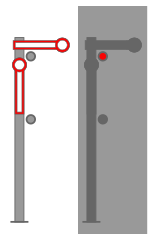 Sr1 stop |
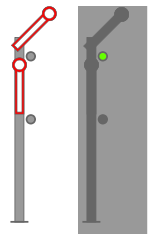 Sr2 clear |
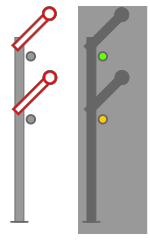 Sr3 clear slowly (40 km/h) |
| Mechanical distant signal | ||
 On/Od1/Ot1 expect stop |
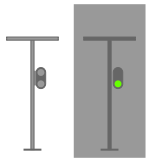 Od2/Ot2 expect clear |
 Ot3 expect clear slowly |
| Mechanical shunting signal | ||
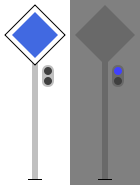 M1 shunting forbidden |
 M2 shunting allowed |
|
See also
- Osshd railway signalling